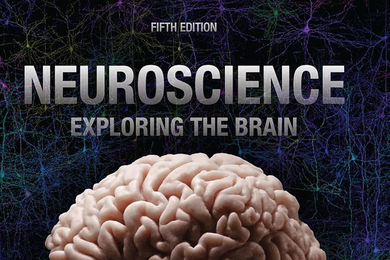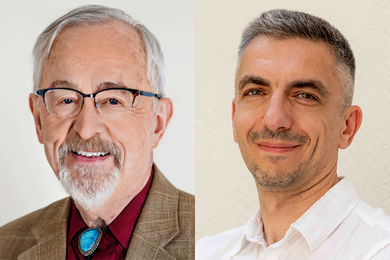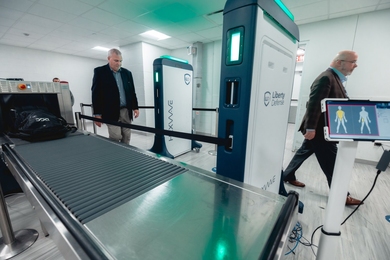This is an edited version of an article that was originally published in the winter 2001 issue of Spectrum.
Five years ago, Saul Simon admits, he hit a low point.
Retired from a highly successful career in the clothing business, he'd lost both sight and hearing to a progressive disease called Usher's Syndrome. That in turn meant other losses, including friendships.
The only way he could take in information, said the Needham resident, was to have people print letters with a finger in the palm of his hand. "When you go out to dinner with friends, how many of them are going to want to print letters on your palm?" he says.
Urged on by his wife and children, Mr. Simon agreed, albeit nervously, to undergo surgery to get an inner-ear device called a cochlear implant -- a sophisticated instrument whose development has been significantly advanced by MIT researchers.
After the prescribed healing time, he started hooking up the implant's processor. This cigarette-box-sized apparatus includes a microphone and links to a device called a stimulator that's implanted under the skin behind the ear.
At first, as his doctors had warned, the device was useless. "Everything sounded like Donald Duck," recalls Simon. But, following instructions, he kept using it.
"One day," he remembers, "I hooked it up, went down to the kitchen, and my wife said, 'Good morning.'" I couldn't believe it! 'I heard you,' I told her, 'I understand you!' And then I ran around turning on the water, ringing the doorbell, anything you can imagine!"
Today, Mr. Simon can hear pretty well on the phone and better yet in one-on-one situations; he can listen, within limits, to music; and he can again socialize with friends. "I've got my life back," he says.
He is one of about 500,000 Americans who are profoundly hearing impaired. It's a tough condition, said Donald Eddington, an expert on cochlear implants with MIT's Research Laboratory of Electronics and the Harvard-MIT Division of Health Sciences and Technology. Dr. Eddington also works with Mr. Simon's physician, Dr. Joseph Nadol, at the Massachusetts Eye and Ear Infirmary (MEEI).
In the late 1970s, Dr. Eddington got into the field of using electrical stimulation to boost hearing in the profoundly deaf. It was a field then rife with controversy, most of it focused on cochlear implants -- instruments whose business end is an electrode bundle that doctors surgically place into the cochlea.
The cochlea is spiral-shaped organ, smaller than the nail on a little finger, that turns sound waves into electrical signals. The key to this capability is the cochlea's hair cells. These cells are invisible to the naked eye, and their hairs are one one-hundredth the diameter of those on our heads. But their subtle movements in response to sounds are what let us converse, enjoy music and instantaneously tell where a blaring horn's clangor is coming from.
The problem for cochlear-implant experts is that there are 15,000 hair cells and twice that many auditory nerves. Early implants, with just one electrode, presumably resulted in all excited nerve fibers responding similarly. The luckiest users scored about 5 percent in identifying a list of common words like "lot" and "home." They could lip-read pretty well if no other sounds interfered. And they could do some basic communicating by phone.
"If someone asked their spouse what was for dinner," said Dr. Eddington, "they might able to tell the difference between 'mashed potatoes' and 'green peas.'"
The gains were so modest and so chancy that many said no to implants. But Dr. Eddington -- who heads a cochlear implant laboratory run collaboratively by MIT, Harvard and MEEI -- said performance has improved dramatically since. Typical users today score 40 percent on word tests, talk freely on the phone and hold conversations in quiet circumstances with little if any lip-reading.
What led to such improvements? One key, pioneered by Dr. Eddington, was to move to six-electrode implants. Others reflect advances in sound-processing techniques: for example, avoiding interference between electrodes.
The cochlea is filled with a conductive fluid, noted Dr. Eddington, so when one electrode fires, "current spreads all over, and there's interaction between electrodes."
His solution was to phase the activation of the electrodes. With tiny gaps between each firing, hearing improves markedly.
Dr. Eddington is now working on a system with two sixteen-electrode arrays -- one for each ear. "We have good evidence that the brain can integrate information from two implants," he said.
Such a device might solve what's sometimes called the cocktail-party problem. "A sound coming from your side will be stronger in the ear on that side, and will also get to that ear before the other one. Being able to localize sound sources is the one thing that helps us in conversations at parties," he said.
Other groups are looking for gains elsewhere -- for example, by creating better links between electrodes and the auditory nerves.
Dr. Eddington believes that one way or another, major new strides are coming. "This is a field that's accelerating," he said. "Given the progress we've seen already, I think there's great promise for new developments over the next 10 to 15 years."
The work is funded by the National Institutes of Health, the W.M. Keck Foundation and Advanced Bionics Corp.
A version of this article appeared in MIT Tech Talk on February 28, 2001.





